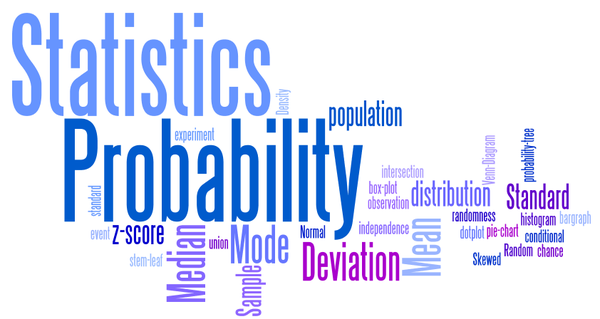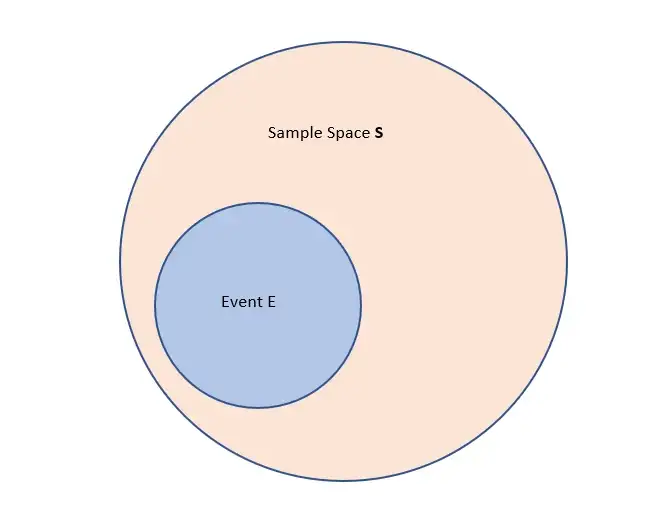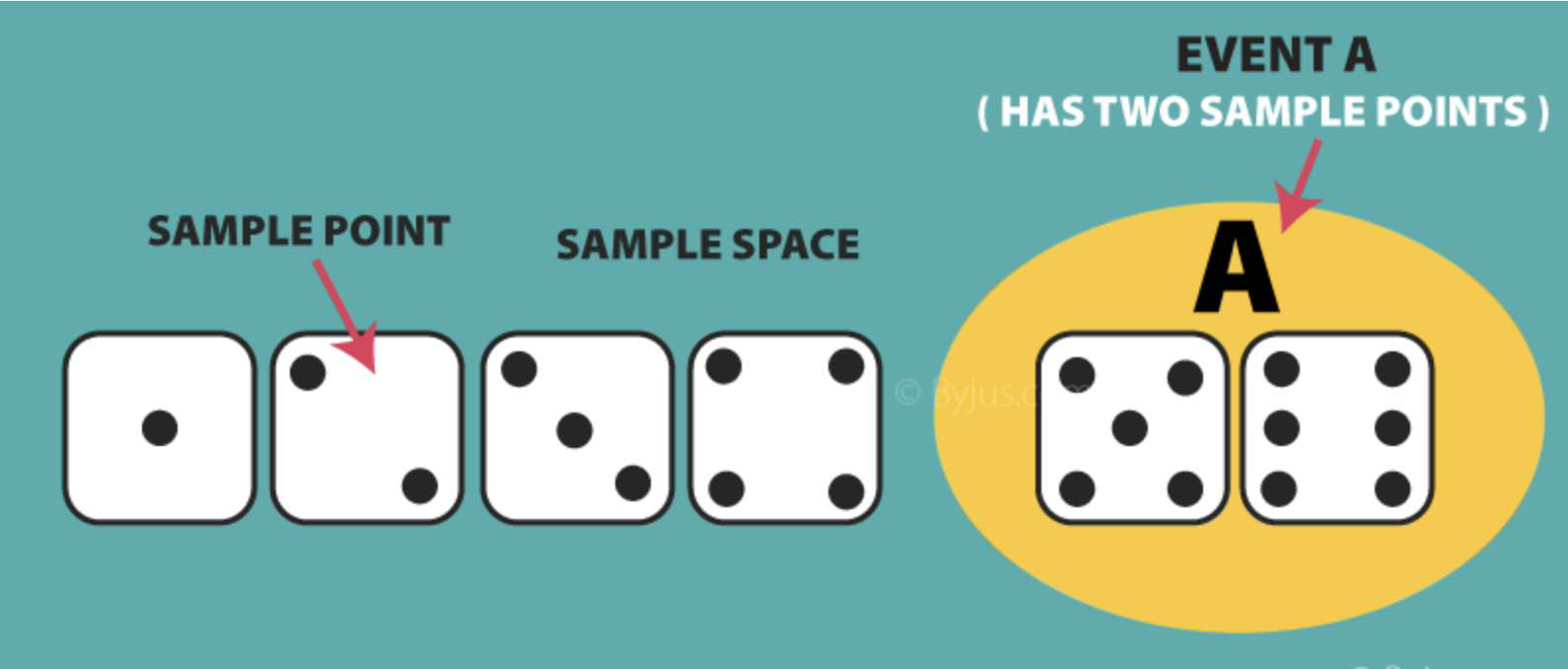What is Probability
Definition
Probability is the branch of mathematics that deals with the occurrence of a random event.
Probability is the measure of the likelihood of an event to happen.
Probability is the study of randomness and uncertainty. Probability theory is widely used in the area of studies such as statistics, finance, gambling, artificial intelligence, machine learning, computer science, game theory, and philosophy.

Applications of probability
Some of the applications of probability are predicting results of the following events:
Minor
that a customer will buy milk if they are also buying bread.
Of getting at least 2 heads in 5 coin flips.
Getting 3 and 5 on throwing a die.
Pulling a green candy from a bag of red candies.
Winning a lottery 1 in many millions.
# of customers arriving at a bank in a week
Major
It is used for risk assessment and modelling in various industries
Weather forecasting or prediction of weather changes
Probability of a team winning in a sport based on players and strength of team
In the share market, chances of getting the hike of share prices
Probability Terminology
The first thing we do when we start thinking about the probability list a number of things that could possibly happen.
Some of the important probability terms are discussed here.
Sample Space
Sample space of an experiment, denoted \(S\), is the set of all possible outcomes of an experiment or trial.
Suppose that we toss a die. Six numbers, from 1 to 6, can appear face up, but we do not yet know which one of them will appear. The sample space is S = {1,2,3,4,5,6}.
For tossing is a fair coin, the sample space is S = {H, T}
Image from byjus.com & medium.com
Experiment or Trial
Experiment is any action or process that generates observations or outcomes.\ E.g. The tossing of a coin, selecting a card from a deck of cards, throwing a dice etc.
Outcome or Sample Point
An outcome is a possible result of an experiment or trial.
E.g. The outcome of tossing a coin is a head or a tail.
Roll a die, the outcome is a number between 1 and 6. Each of the six numbers is a sample point
Event
Event is any possible outcome, or combination of outcomes, of an experiment.
E.g. Getting a Head while tossing a coin is an event.
Cardinality
Cardinality of a sample space or an event, is the number of outcomes it contains. \(|S|\) represents the cardinality of the sample space.
Tossing a coin, \(|S|\) = 2, Rolling a die, \(|S|\) = 6
Flip a coin twice, S = {00,01,11,10} \(|S|\) = 4
Flip a coin until you get a tail. \(S=\{1,01,001,0001, \ldots\}\) \(|S| = \infty\)
Population
Those individuals or objects from which we want to acquire information or draw a conclusion.
E.g. All valves produced by a specific manufacturing plant.
All adult females in the United States.
All smokers
Sample
Most of the time, the population is so large, we can only collect data on a subset of it. We will call this our sample.
Sets and Subsets
A set is defined as a group of objects (i.e., sets can be made up of letters, numbers, names, etc.).
A subset is defined as a set within a set. set A is a subset of set B if and only if every element of A is also in B.
Empty Set
The set that contains nothing, denoted \(\emptyset\).
Complement
\(A^c\) = A complement. This is a shorthand way of saying when A does not occur. This set is made up of everything not in A.
Parameter
Parameters are the unknown values of an entire population, such as the mean and standard deviation. Samples can estimate population parameters but their exact values are usually unknowable.
Interview Question
Q: What is the sample space of rolling Two Dice?
Ans: The total number of joint outcomes (a,b) is 6 times 6 which is 36.
Axioms of Probability
- Axiom 1:
For any event, ‘A’ the probability of possible outcomes is either 0 or 1, where 0 is the event which never occurs, and 1 is the event will certainly occur. For any event \(A, 0 \leq P(A) \leq 1\).
- Axiom 2:
The sum of probabilities of all possible outcomes is 1.Probability of the sample space S is \(P(S)=1\).
- Axiom 3:
If \(A_{n}\) mutually exclusive events (intersection of any two is the empty set) then \(P\left(\bigcup_{i = 1}^k A_n\right) = \sum_{k=1}^{n} P\left(A_{k}\right)\)
- Axiom 4:
The complement of any event A is the event that consists of all the outcomes that are not in A.
- Axiom 5:
If both A and B are independent, then the conditional probability that event B occurs given that event A has already occurred. P ( A and B) = P (A) P (B | A). This is called the General rule of multiplication.
Counting
Despite the trivial name of this topic, be assured that learning to count is not as easy as it sounds.
Naive Probability
The probability of an event occurring, if the likelihood of each outcome is equal, is:
When we are working with probabilities, our notation will be P(A). this means the Probability that event A occurred. So, if A is the event of flipping heads in one flip of a fair coin, then P(A) = .5
This Naive Definition is a reasonable place to start, because it’s likely how you have calculated probabilities up to
this point. Of course, this is not always the correct approach for real world probabilities (hence the name naive).
Multiplication Rule
To understand the Multiplication Rule, visualize a process that has multiple steps, where each step has multiple choices. For example, say that you are ordering a pizza.
Size (small, medium, or large)
Topping (pepperoni, meatball, sausage, extra cheese)
Order Type (delivery or pickup)
Using the multiplication rule, we can easily count the number of distinct pizzas that you could possibly order. Since there are 3 choices for size, 4 choices for toppings, and 2 choices for pickup.
we simply have 3 ⋅ 4 ⋅ 2 = 24 different pizza options.
Now that we have counted the total of number of possible pizzas, it is easy to solve various probability problems.
Interview Question
Q: What are the outcomes of flipping a fair coin and simultaneously rolling a fair die?
Ans: 6 x 2 = 12 outcomes.
Q: How many possible license plates could be stamped if each license plate were required to have exactly 3 letters
and 4 numbers?
Ans: 26 x 26 x 26 x 10 x 10 x 10 x 10 = 175,650,000
Factorial
You may have used the factorial for simple arithmetic calculations.
Another use for the factorial function is to count how many ways you can choose things from a collection of things or find how many ways things can be arranged.
Example
Counting the the number of ways to order the letters A, B, and C. We will define a specific arrangement or order as a permutation. You could likely figure this out by just writing out all of the permutations:
{ABC,ACB,BAC,BCA,CAB,CBA}
It’s clear that there are 6 permutations. what if you had to do the same for all 26 letters in the alphabet? if you didn’t feel like writing out the 26 letters over and over and over, you could use the factorial for a more elegant solution.
the number of permutations when ordering A,B and C is 3!
3 ⋅ 2 ⋅ 1 = 6
Another example, In how many ways can 7 different books be arranged on a shelf?
We could use the Multiplication Principle to solve this problem. We have seven positions that we can fill with seven books. There are 7 possible books for the first position, 6 possible books for the second position, five possible books for the third position, and so on. The Multiplication Principle tells us therefore that the books can be arranged in:
Alternatively, we can use the simple rule for counting permutations. P = 7! = 5040
Python Solution
from math import factorial
print(factorial(3))
print(factorial(6))
6
720
Binomial Coefficient
The binomial coefficient is a mathematical formula that counts the number of ways to choose k items from a collection of n items. This is perhaps the most useful counting tool. which in english is pronounced n choose x = \(\tbinom{n}{k}\).
With replacement
means the same item can be chosen more than once.
Without replacement
means the same item cannot be selected more than once.
Permutation
Permutation relates to the act of arranging all the members of a set into some sequence or order.
Any ordered sequence of k objects taken from a set of n distinct objects is called a permutation of size k.
When selecting more than one item without replacement and order does matter.
Example
Suppose an organization has 60 members. One person is selected at random to be the president, another
person is selected as the vice-president, and a third is selected as the treasurer.
How many ways can this be done? (This would be the cardinality of the sample space.)
Combination
When selecting more than one item without replacement and order does not matter.
Given n distinct objects, any unordered subset of size k of the objects is called a combination.
Example
Suppose we have 60 people and want to choose a 3 person team (order is not important). How many combinations are possible?

Suppose we have the same 60 people, 35 are female and 25 are male. We need to select a committee of 11 people.
How many ways can such a committee be formed?
What is the probability that a randomly selected committee will contain at least 5 men and at least 5
women? (Assume each committee is equally likely.)
What is the probability of drawing the ace of spades twice in a row? (Assume that any card drawn on the first draw will
be put back in the deck before the second draw.)
You draw a card from a deck of cards. After replacing the drawn card back in the deck and shuffling thoroughly,
what is the probability of drawing the same card again?
Use $n \choose k$ to calculate the probability of throwing three heads in five coin tosses.
Twelve (12) patients are available for use in a research study. Only seven (7) should be assigned to receive the study
treatment. How many different subsets of seven patients can be selected?
Torch combinations
import torch
a = torch.tensor([1, 2, 3])
print(torch.combinations(a))
print(torch.combinations(a, r=3))
torch.combinations(a, with_replacement=True)
tensor([[1, 2],
[1, 3],
[2, 3]])
tensor([[1, 2, 3]])
tensor([[1, 1],
[1, 2],
[1, 3],
[2, 2],
[2, 3],
[3, 3]])
Difference Between Permutation and Combination
Permutation |
Combination |
|---|---|
Order matters |
Order doesn’t matter |
Number of ways to arrange the elements of a set. |
Number of ways to choose k elements from a set of n elements. |
Arranging people, digits, numbers, alphabets, letters, and colours. |
Selection of menu, food, clothes, subjects, the team. |
Picking a President, VP and Waterboy from a group of 10. |
Picking a team of 3 people from a group of 10. |
Listing your 3 favorite desserts, in order, from a menu of 10. P(10,3) = 720. |
Choosing 3 desserts from a menu of 10. C(10,3) = 120. |
Sampling Table
Order Matters |
Order Doesn’t Matter |
|||
With Replacement |
\(n^k\) |
\({n+k-1 \choose k}\) |
||
Without Replacement |
\(\frac{n!}{k!(n-k)!}\) |
\(\binom nk\) |
Interview Questions
There are 25 students in a class. Find the number of ways in which a committee of 3 students is to be formed?
25 choose 3 2300In a meeting between two countries, each country has 12 delegates. All the delegates of one country shake hands with all delegates of the other country. Find the number of handshakes possible?
Total number of handshakes = 12 x 12 = 144How many groups of 6 persons can be formed from 8 men and 7 women?
Total number of person = 8 men + 7 women = 15
15 choose 6 = 5005

